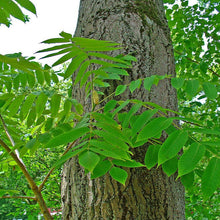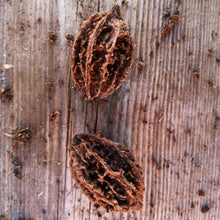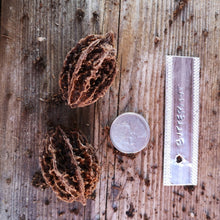|
Mature height x width: |
approx 60-110' x 40' |
|
Recommended initial spacing: |
5'-10' in rows 20' apart (to be thinned later) |
|
Recommended final spacing: |
40' x 40' (butternuts are not grown commercially so little spacing info is available) |
| Hardy to: | approx -40°C |
|
Preferred soil: |
adaptable to different soil types. Prefers loam. |
|
Good for: |
fresh eating, cooking, baking, timber |
|
Uses: |
dessert, main dish |
Butternut trees are not well-known as a nut tree, but they are the hardiest member of the walnut family (hardy to Zone 3!), producing great-tasting nuts and high-quality wood. Also known as 'white walnut', the butternut (Juglans cinerea) is native to the eastern US and Canada. They are endangered due to an introduced fungal canker disease, but this fungus may be absent in other regions. The nut shell has deep ridges and it can be very difficult to crack and extract the nut meat.
Genetics: The parent tree 'Booth' was selected for easy cracking, so these seedlings have a good chance of being easier to crack than their wild counterparts.
Planting: butternuts do best in loam, but they are tolerant of a variety of soil types. They can tolerate shade, but expect slow growth and limited yields in the shade.
Why seedlings? Growing seedlings from productive, vigorous parents helps maintain diversity (each seed is a new variety) while drawing on some of the best genetics available. In other words, by planting seedlings, you are participating in the breeding and selection of new, regionally-adapted varieties!
Why bare root? "Bare root" means that the tree has been grown in the ground (rather than in a pot). In general, bare root trees tend to have larger root systems because their roots aren't constricted by the edges of the pot. Because we don't need to use pots or potting soil, we can sell them more cheaply than potted trees. Bareroot trees must be planted when they are still dormant (Nov - Mar in our region).





